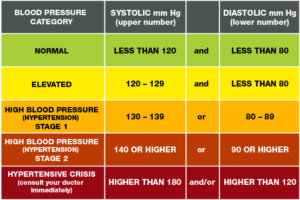Blood Pressure Uncuffed™ Volume 4: Understanding my Blood Pressure Reading
December 15, 2023. By Sophie Cook
You may know how to measure your blood pressure and what your last reading was, but do you know what those numbers really mean? Blood pressure readings can be confusing and not much help when you don’t understand what you’re looking for. But it’s important to know your BP and keep it in a healthy range so that you don’t develop hypertension (high blood pressure). Blood pressure is described by two numbers, the first being systolic, and the second diastolic. There are 5 different categories of blood pressure, knowing where your numbers fall is key to monitoring your health. The following are different blood pressure categories according to the American Heart Association (2).

Normal
Having “normal” blood pressure is any reading where your systolic number is less than 120 and diastolic less than 80. If you have blood pressure readings consistently in this category that’s a great sign your lifestyle choices like regular exercise and a balanced diet are working.
Elevated
“Elevated” blood pressure is a systolic reading of 120-129 AND a diastolic reading of less than 80. If your readings are falling into this category, it’s important to implement heart healthy habits to keep your BP in check before you develop high blood pressure.
Hypertension Stage 1
If your blood pressure readings are consistently between 130-139 (systolic) OR 80-89 (diastolic), you are considered to be in the hypertension stage 1 category. In this stage, it is highly recommended to speak with a medical professional for diagnosis and treatment options. Lifestyle modifications is the most likely route of treatment, but medications could be considered.
Hypertension Stage 2
This stage is when you see systolic readings of 140 and higher OR diastolic readings of 90 and higher. At this point doctors will most likely prescribe a blood pressure medication to help lower BP, but lifestyle changes should also be implemented.
Hypertensive Crisis
If you see any systolic readings of 180 and higher AND/OR diastolic readings of 120 or higher, you could be experiencing a hypertensive crisis and should seek medical attention immediately. If you see readings of 180+ (for systolic) or 120+ (for diastolic) you should wait a minute, retake the measure, and if it is still concerning contact medical personnel immediately. If you are experiencing the same high readings with chest pain, shortness of breath, change in vision, difficulty speaking, weakness, or other pain do not wait to retake the measure and call 911 because you could be experiencing a heart attack or stroke (2).
Let’s see if you can identify what categories the following blood pressure readings fall into (scroll to the bottom for answers)
- 106/74
- 130/78
- 144/96
- 122/64
- 118/85
- 162/88
Answers:
- 106/74: Normal. Since the systolic is lower than 120 and the diastolic is less than 80 it is in the normal range.
- 130/78: Hypertension Stage 1. Since the systolic is between 130-139 it falls into the hypertension stage 1 category. The diastolic being 78 may be confusing, but if you look at the chart above, to be in this category only your systolic OR diastolic needs to fall into the range.
- 144/96: Hypertension Stage 2. Since the systolic number is greater than 140, and the diastolic is greater than 90, this fits perfectly into the hypertension stage 2 category.
- 122/64: Elevated. The systolic reading is in between 120-129 AND the diastolic is 64, which is less than 80, so this reading falls into the elevated category.
- 118/85: Hypertension Stage 1. Again, this may be tricky, but we only need either the systolic to be 130-139 OR diastolic to be 80-89. Since the diastolic reading is 85, this would be considered hypertension stage 1, even though the systolic number appears “normal”
- 162/88: Hypertension Stage 2. With a systolic reading of greater than 140, this reading would fall into the hypertension stage 2 category. The diastolic is not greater than 90, but like hypertension stage 1 you only need one or the other (systolic of diastolic) to fall into the range in order to be categorized this way.
As you may notice in the examples above, a diagnosis of high blood pressure can be made from either systolic or diastolic readings (2). It’s extremely important to monitor your blood pressure and understand where your readings fall so you can stay on top of your health. If you want to learn more about what causes high blood pressure and possible symptoms, read our blog here: https://valencell.com/news/blood-pressure-uncuffed-volume-2-what-is-high-blood-pressure-hbp/
Sources: